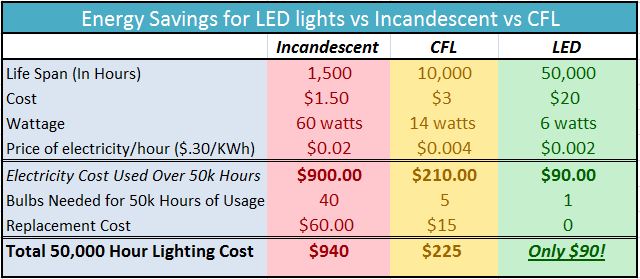15 Must Have Formulas For Calculating ROI For LED Lighting Retrofit
How to Calculate a Basic LED Retrofit ROI Manually
While technology is a great thing to have, it often can be too complicated to really be of any value. Calculating the financial benefits of updating to LED or even Fluorescent lighting can seem like a daunting task. For basic retrofits, you really don't need a computer. You can do all you need with a simple calculator and a basic sheet of paper.
"Get out the pencil and paper"
This article made me think of a Gentleman I used to work for who didn't really even know how to turn on a computer let alone run one. Whenever the server would go down or software would cause problems, he would always threaten to "get out the pencils and paper", back to the way they used to do things.
While I can't imagine doing the accounting functions for a business without a calculator, I do often do a quick, 5 minute series of calculations to see if a retrofit is really worth considering. Afterall, why spend hours and hours of your time trying to figure it out if it's not worth it.
So if you are wondering if a lighting upgrade is a good move for your place of business, we put together the 16 must have formulas to help you figure it out. If it looks like sense on paper, then it may be worth spending a little more time finalizing and calculating further.
But first, there are 9 pieces of information you should assemble in order to make this a quick simple task.
- Hours per day lights are lit.
- Number of days per week they are lit.
- Number of existing fixtures or lamps.
- Wattage of existing lamps.
- Ballast factor of existing lamps.
- Your current kWh rate.
- Estimated cost of yearly maintenance and upkeep.
- Proposed new fixtures or lamp quantity.
- Installation cost of new fixtures.
16 Formulas you need to know:
Calculations for Retrofit and New applications
This set of formulas will allow you to calculate ROI for either Retrofit or New installations.
***Note-If you are calculating NEW installation, follow all the way through, adjustment for NEW application are within the last 2 formulas.
Here we go....
1. Finding fixture hours per year:
Hours per day x days per week x 52.143 weeks = hours per year
You don't have to be perfect here, this is just an estimate. If you work 8 hour shifts, don't forget to add an hour at the end and a hour at the beginning of the day. We often find that there is usually someone there early and late, so you want to take all factors into consideration.
2. Estimating total fixture wattage:
Number of lamps x wattage of lamps x ballast factor = fixture wattage
Number of lamps should be relatively easy to count. To locate wattage of lamps, you can either go up and look at what you have or find the box of replacement bulbs on the shelf and you can find it there. Ballast factor, you would have to take a look at the existing fixture.
Analyzing Your Existing System:
3. Calculate existing energy use (kWh):
Existing fixture quantity x fixture wattage x hours per year = kWh
1000
4. Calculate existing total energy cost per year:
kWh x utility rate = yearly energy cost (in dollars)
 5. Establish maintenance cost:
5. Establish maintenance cost:
Total number of lamps x $6 (estimated industry average) = yearly maintenance cost
Having a good handle on the cost to maintain your system is very important if you are comparing a fluorescent system to a LED system. LED will always cost more upfront for the fixture vs fluorescent, but long term LED will cost you next to nothing for maintenance.
If you are not sure, use the $6 per bulb figure listed in the formula above. That is an established industry average. While you may think it costs nothing, if you really sit down and do a talley of bulbs, ballasts, down time, lift rental, safety, and labor, you will find the $6 figure a pretty close average.
Proposed System:
6. Calculate proposed energy use (kWh):
Proposed fixture quantity x LED fixture wattage (no ballast factor) x hours per year = kWh
1000
7. Calculate proposed total energy cost per year:
kWh x utility rate = yearly energy cost (in dollars)
Keep in mind that you are calculating costs of the existing system and proposed system in TODAY's dollars and utility rates. If you really watch your utility bill closely, you will find out that the rates creep up a little bit each year.
In 5 years if you start to think "why am I not saving the amount per month I estimated 5 years ago", you might want to break down your rates month by month (might need the computer for that). You will likely find a significant increase in your rate over time even though you did not notice the slight changes on the face of your bill.
At a dealership we did 3 years ago, their rate has increased nearly 40%, so I am talking from experience. Just something to keep in mind.
8. Establish installation cost:
Proposed fixture quantity x installation cost per fixture = total installation cost
9. Establish fixture cost:
Proposed fixture quantity x proposed fixture cost = total fixture cost
10. Total cost for proposed system:
Total installation cost + total fixture cost = total cost of proposed system
Determining simple payback (in years):
11. Calculate yearly energy savings:
(Existing kWh – Proposed kWh) x utility rate = yearly energy savings (in dollars)
12. Calculate yearly savings:
(Proposed total energy cost + proposed total maintenance cost) - (Existing total energy
cost + existing total maintenance cost) = annual savings (in dollars)
13. Simple payback formula:
Total cost of proposed system = simple payback (in years)
Annual Savings (in dollars)
What about NEW installations?
For new construction ROI calculations, you will need to subtract the cost of the existing system total from the total cost of the proposed system.
This number will be your new total for proposed system as shown below.
New Build formulas:
14. Establish additional proposed cost:
(Proposed fixture cost + Proposed installation cost) - (existing fixture cost + existing
installation cost) = adjusted proposed system cost
15. New build simple payback formula:
Adjusted proposed system cost = new build simple payback (in years)
Annual Savings (in dollars)
Learn More...
Related Articles: